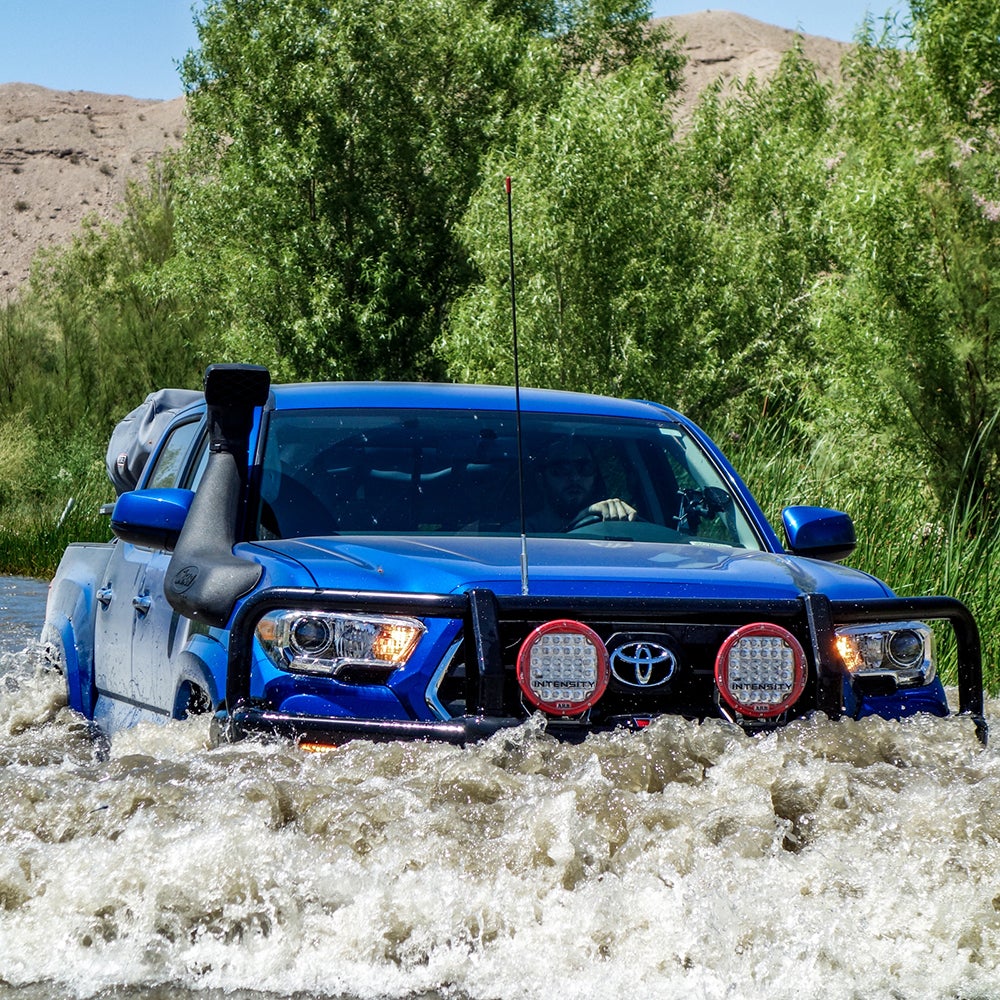First, it was a route used by the Mojave people to move trade goods from the interior of the Southwest to coastal tribes like the Chumash. Then it became a wagon trail for settlers moving west. Today, you can still drive 130 or so miles of the Old Mojave Road as it passes through the Mojave National Preserve. It’s one of the most unique, varied, and just plain long 4×4 routes you can drive in California.
The Drive
My friend Matt and I have been trying to figure out a trip the two of us could go on for a while. He lives in Seattle, and I live in Los Angeles, so that’s a littler harder than just saying “What’s up?” on a Friday afternoon. Luckily, he works for aftermarket 4×4 specialist ARB, and they had a truck sitting at a repair shop in Orange County that needed to be picked up, and driven back north. He could move his flight forward a few days, if we could find something fun to do in the meantime.
Starting a little over an hour outside LA, the Old Mojave Road sounded like the right challenge. We read advice online that said to allow two to three days to complete it, and to bring at least two trucks, in case one got stuck. We decided to ignore that last part and leave my Land Rover at home, mostly just because two trucks for two people sounded wasteful. So, we filled up the Toyota’s onboard fridge with beer and ribeyes, and hit the road at 10:30 last Thursday morning.
After dealing with bad, unpredictable drivers, and an utter lack of lane discipline, you eventually turn off the 15, cross some train tracks, and start the route unceremoniously on a simple dirt road that just heads off into the big, flat desert. Those simple sandy washes are a good warmup for the route’s biggest challenge, a deep water crossing through the Mojave River, that comes just a few miles in.
Water crossings are unpredictable by their very nature. The depth and flow rates of a river alter hour to hour, much less day to day, or week to week. And with those variances can come obstacles, carried down stream, or stirred up by currents or other vehicles. A crossing that was simple the last time you came through, or when your friend did it, could be deadly this time. And there’s never really any way to fully evaluate the risks before you just drive on in. This Thursday, the river looked calm, about hood high, and the ample cottonwoods and reeds should have held any big rocks back during the last flood, so we just decided to give it a go. 4 Low, both diffs locked, and we plunged in up to the hood line. This truck is lifted 2.5 inches, on taller, 33-inch tires. So that hood probably sits four to five inches higher than stock. The water was high enough that we were glad to have our snorkel even in this truck; the crossing wouldn’t have been possible in a stock truck or SUV. Wiley splashed around in the shallows as Matt put the Tacoma in reverse, and went back for a photo pass.
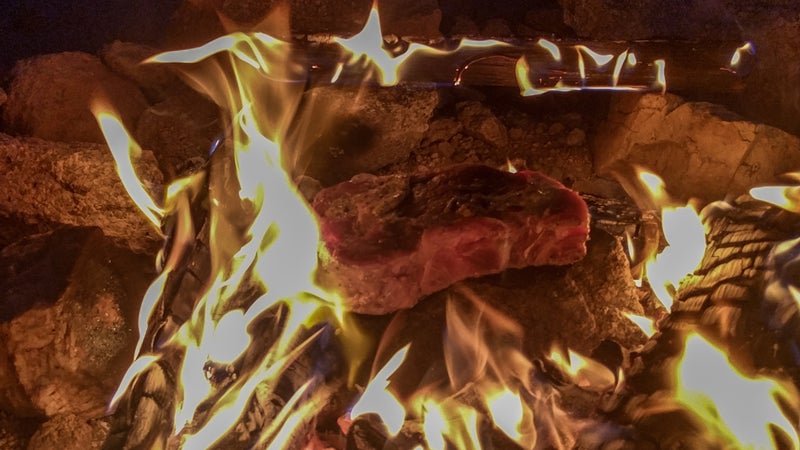
The next few dozen miles of trail pass through deep sand, as you wind your way through canyons. The rocks on the walls change color from red, to white, to grey, and you can pick out old mine tailings up on the hills too. But the surface just remains deep, fine sand that feels like talcum powder. It looks and feels simple to walk on, but heavy vehicles just sink right into it, then struggle to find traction. Driving through it at 30 to 40 mph, in two-wheel drive, with the rear air locker engaged, was a real blast. Sort of a rally course or snow drive, just in slow motion, as you keep the throttle planted and wind on opposite lock to correct the power slides. Even re-geared, the Toyota’s V6 barely had enough torque to make headway, it’s easy to picture plenty of people on inadequate tires, or without diff locks, getting stuck here.
Out of the sand and onto hard, dried mud as the trail passes Zzyzx Springs. You’ve been curious about the road sign on the way to Vegas, and what’s down it is a derelict healing center and resort that was built by a televangelist and con man back in the 1940s. He advertised the place as the “last word” in health, and chose the name because it was the last word in the English dictionary. Curtis Howe Springer made various far-fetched claims about the healing properties of the Zzyzx water, including its ability to reverse baldness. The various lawsuits and shady real estate business deals added up, and Springer was was evicted in 1974. You can still see palm trees, water tanks, and weird concrete structures a mile or so off the trail.
The huge plain of dried mud it sits adjacent too would be utterly impassible for any wheeled or tracked vehicle if it was wet. As it stands, it’s just a bumpy two-track through the sun-beat middle of nowhere.
Climbing out of Zzyzx Valley, you enter fields of sharp, black volcanic rock. And in those, you’ll find the Mojave Lava Tubes. They’re largely unmarked, but get the GPS coordinates right, and you’ll be able to climb down a set of steel stairs (I had to carry Wiley down). Crawl on hands and knees through a pitch-dark passage and you emerge into a large cavern with holes in its roof, through which sun beams can enter at the right time of day. We’d just missed their full show, but I was still able to get a pretty decent shot of Wiley, staring up at the blue-haired ghost of an old Mojave man.
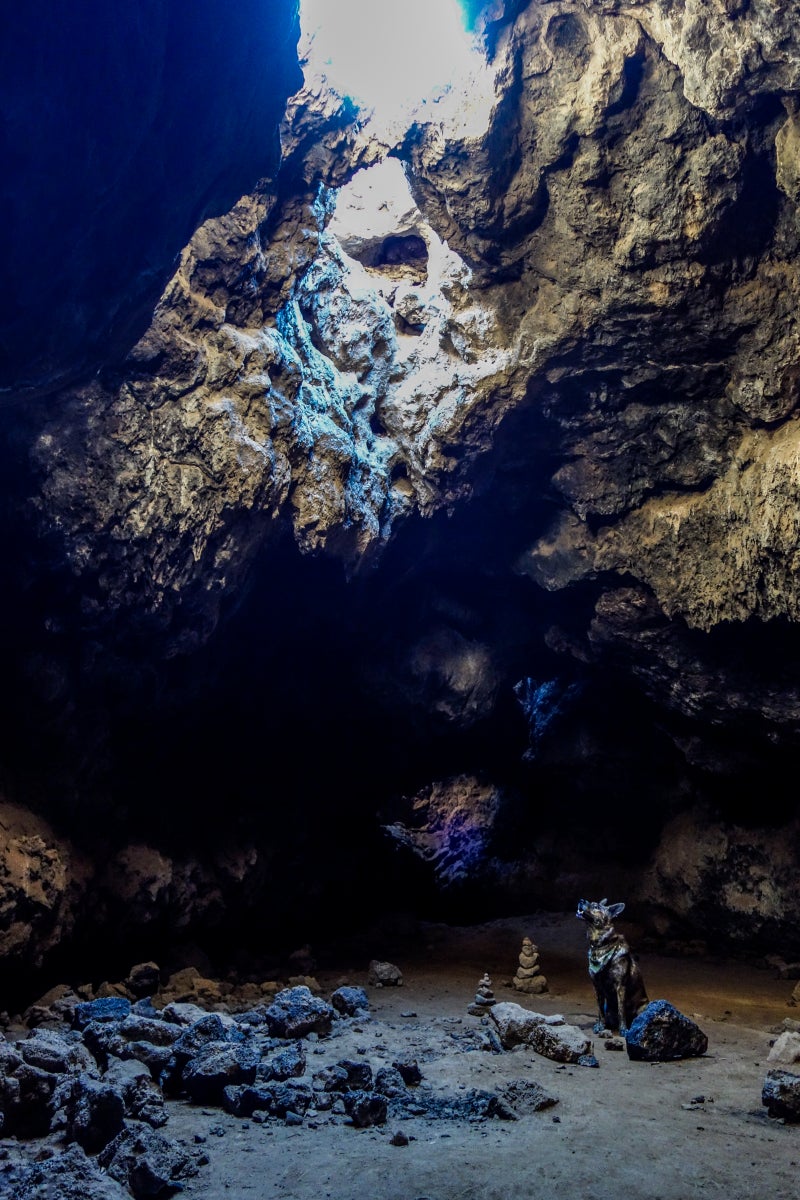
Just past the tubes is the mailbox, marking roughly the halfway point of the trail. It’s tradition to sign your name, then take a picture, so others can see who’s passing through. In the box are a few helpful items for needy travelers, including zip ties (we took one to re-connect a wayward license plate), a wrench, a box of fuses, and a warm can of Natural Light.
From there, the trail becomes a seemingly endless series of sandy whoops, created by rain runoff as it cascades through the gentle slope of the desert once every decade or so. Eventually, you’ll reach the only real campsite on the whole road, but it had two trucks in it, so we circled back to Marl Springs, pitched the ARB rooftop tent, built a fire, cooked some steaks on a rock, and watched the stars.
The next day, the trail entered more populated parts of the Preserve, and we were treated to some graded dirt roads, as well as the most difficult climb of the trip. Here, closer to the eastern end of the Preserve, a few people still live, and a railway once passed through, so there’s multiple dirt roads, all sort of heading in the same direction. We didn’t have to do the climb, but figured we’d give it a try anyway. The run up to the hill was very narrow, and would have pin striped the side of a full-size truck, while the chassis twister bumps and divots came close to maxing out the break over angle of the Tacoma, even on this lift. Still, with mud terrains and locking diffs, it was nothing 4 Low couldn’t handle.
Just before the Preserve peters out into flat desert, the trail passes through a steep, rocky pass. And you have to drive around multiple “Warning,” “Emergency,” and “No Admittance,” signs to keep going. Turns out there’s a couple small washouts that eat away half the trail’s width in a couple places. Get it wrong, and you could roll your truck down into a steep ravine, or simply upend it completing an otherwise simple, but off-camber climb.
Technically, the Old Mojave Road finishes on the Colorado River, just across the Nevada border in Fort Mojave. But, that last 14 miles of trail past highway 95 is just boring, flat, bumpy desert, so we just hit the highway, and headed for home. Back in Los Angeles by 5 p.m. on the second day, this was a fun 4×4 trip that’s super accessible, but feels like a real adventure.

The Truck
For 2016, Toyota finally upgraded the incredibly long-in-the-tooth Tacoma with a restyled body, upgraded interior, and most importantly, a new engine and transmission. The old 4.0-liter V6 and 5-speed auto the new 3.5-liter V6 and 6-speed replace was just a terrible pairing, that lacked both torque and the ability to use it. The new powertrain is much improved, but still can’t rival the refinement or power (or, in some cases, even the fuel economy) of the latest generation of full-size trucks, and the transmission still spends over half its time hunting for gears. Adding insult to injury, the thing’s weak approach and departure angles, not to mention the incredibly long break over, seriously limit its off-road potential in stock form.
The base 4×4, four-door Tacoma starts at $ 31,740. You can achieve some off-road ability in stock form by opting for the TRD Off-Road package, which ups the price to $36,250. But for that $4,510 premium, you only get a single locking differential, a small lift courtesy of very basic Bilstein shocks, and a brake-based terrain select system that’s pretty much worthless. You can actually address most of the Tacoma’s shortcomings, for similar money, by starting with a base-spec truck and turning to the aftermarket. Let’s show you how.
As a show truck, the ARB Tacoma you see pictured is pretty over-the-top. So let’s focus only on the essential modifications you need if you just want to get your Taco dirty:
OME BP-51 Suspension ($3,340): This is an all-new style of suspension from Old Man Emu that brings super high-quality internal bypass, external reservoir shocks to the Tacoma, with a 2.5-inch lift. They ride incredibly well on the rough stuff, don’t bottom out, and generally add the ability to carry roughly twice the speed over a given terrain while being less harsh to the rest of your vehicle’s systems.
ARB Air Lockers Front and Rear ($1400): These provide traction by locking both wheels on an axle together, on demand. Unlike Toyota’s rear locker on the TRD Off Road, you’re also able to switch on the ARB lockers at any speed, and you can operate the rear while in 2WD. Doing so really helps the vehicle retain traction and performance in loose conditions, without slowing to a crawl and using 4 Low.
ARB Summit Bumper ($1,600): More clearance, and more protection, while giving you the ability to mount a winch and lights, and while retaining stock crush rates so your airbag will work as normal.
Warn Zeon Winch ($980): Gives you the ability to get your truck unstuck from anything, or pull another truck out of a sticky situation.
That’s only $2,810 more than the TRD Off Road, but gives you the kind of legitimate off-road ability that will make trips like the Old Mojave Road not just possible, but fun. It’s what you need if you want to take your Taco anywhere. The best part? You can package ARB parts into your finance deal at many Toyota dealers, while retaining your warranty.
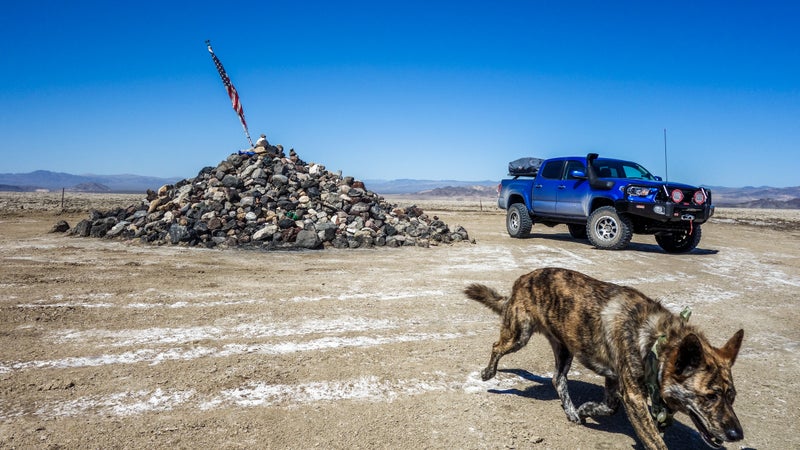
How You Can Do It Yourself
Get over the hurdle of acquiring a good 4×4, and you’ll have everything you need to go tackle the Old Mojave Road yourself. Just maybe wait until fall, it’s 110 degrees in Zzyzx today.
What type of vehicle do I need?
This is not Subaru or modern Jeep Cherokee territory. You need a real body-on-frame truck with a real four-wheel drive system. A stock Wrangler would work just fine, as would a lightly modified Grand Cherokee. Or a $600 XJ with some shade tree mods. You’d just have to go pretty slow, unless you upgraded to a more fully-built truck, as we were table to take advantage of.
As with any off-road driving, you’ll need a good set of tires. I was not a fan of the Cooper STT Pro’s on the ARB Tacoma, they were possibly the noisiest tires I’ve ever used on-road. A much better option would, as always, be to go to TireRack, order a set of BF Goodrich All-Terrain K02s in the appropriate size, and have them delivered to an installer near you. Those are your best bet not only for puncture resistance and traction off-road, but performance, ride, and noise on it.
If the water is up in the Mojave River, it may be a really, really bad idea to take a vehicle not fitted with a snorkel. Inhaling water is the fastest way to destroy your engine and strand yourself in the desert. There’s no way around this crossing.
What supplies should I bring?
The usual off-road stuff, like a tire repair kit, full-size spare, air compressor, shovel, basic tools, Fix-a-Flat, extra fuel, as well as plenty of water.
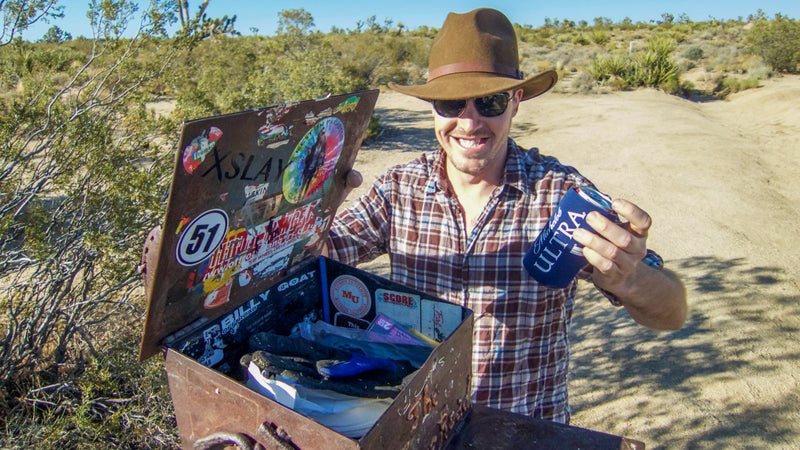
How do I navigate?
You’ll largely be out of cell phone range, and on routes you can’t find on Google maps. And the roads are pretty confusing out here, so being able to see exactly where you are, in a confusing puzzle, is a big help. You’ll want a powerful offline GPS navigation app. We used Hema Explorer on this trip, but Gaia GPS (iOS) or Backcountry Navigator (Android) are equally capable. Running that on the large screen of an iPad or similar tablet is also a big help. Here's waypoints.
What is there to see and do?
The lava tubes are definitely worthwhile, and you can hike to some of the old forts, but really, you’re coming out here to go off-roading, and enjoy a nice campout. It’s going to be hot during the day, but pleasant at night, so find a nice place to camp, bring firewood to have a fire, cook some good food, and enjoy the stars.
The best campsite anywhere near the halfway point (Mojave Camp) is popular, and even on a scorching hot weekday there were already two groups in it when we arrived. And there aren’t a lot of other options. You will find places in the lava fields that work, or back near the river crossing. It’d make more sense, from a camping perspective, to run the route east-to-west.
Should I be scared?
There’s rattlesnakes, if you got stuck out here without water things would go badly for you, there’s a bunch of cactuses, and a bizarrely high number of bees. None of that is going to be a problem if you prepare adequately, and use common sense. It’s a harsh environment out here, make sure you vehicle is in good working order, bring tools to fix it, know how to use them, and bring extra water, sunscreen, shade, and maybe even a radio.
The biggest problem we ran into was when Wiley ran through a cholla cactus in pursuit of a hare. I filled my hands up with barbs pulling them out of his fur, while he wiggled and complained. There’s also a bunch of coyotes; we heard them kill something just outside of camp during the night.
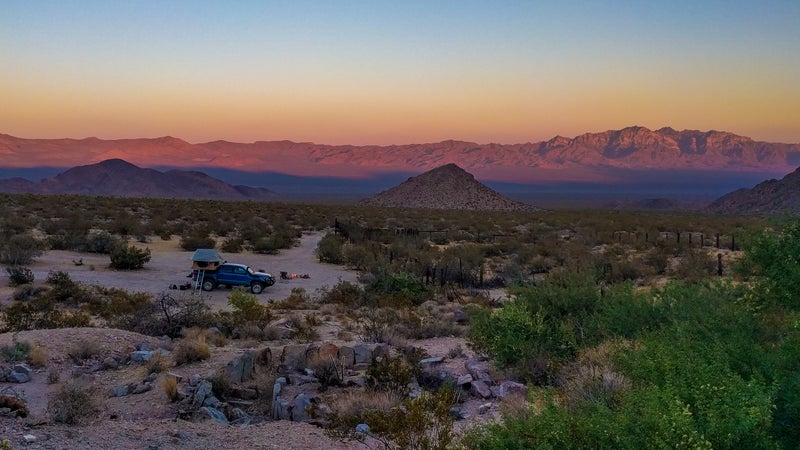
Should I go?
This is one of the neatest desert excursions in the Southwest, and it’s easily accessible from Los Angeles, San Diego, or Las Vegas. Go in the spring, fall, or winter and you’ll be treated to mild weather, beautiful scenery, and a fairly challenging drive. It’s really neat following the same tracks settlers once rode over in their wagons, and doing that really puts the epic nature of their journey into perspective. You’ll have a hard time in your fancy $40,000 truck, imagine how difficult it must have been going walking pace between watering holes that were 60 miles apart.


